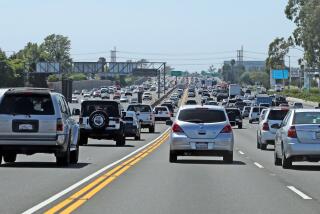Getting a move on speed enforcement
- Share via
Kill a person while you are driving drunk and you probably will get a stiff prison sentence. But if you’re a habitual speeder who jokes about breaking traffic laws, you probably will walk away from a fatal crash with a light sentence.
That’s the message highway safety experts draw from the sentencing of William J. Janklow, the former member of Congress who killed a motorcyclist after he blasted through a stop sign in Flandreau, S.D.
Janklow, who often made light of his history of speeding tickets, resigned from Congress in December after a jury convicted him of manslaughter.
Last month, Janklow was sentenced to 100 days in a county jail; after 30 days, he will be allowed to leave the jail for 10 hours a day. By contrast, an impaired-driving manslaughter conviction typically carries a multiyear prison sentence.
The American public views speeding pretty much the way it viewed drunk driving 30 years ago: something that is common, widely accepted and not criminally irresponsible.
“Attitudes have changed toward alcohol and driving but not toward speeding,” said Brian O’Neill, president of the Insurance Institute for Highway Safety. “They are equally egregious behaviors because the outcomes are the same. But public policy does not recognize this.”
Speeding is involved in one-third of highway deaths, or about 14,000 fatalities a year. The federal government has put a lower priority on the problem, focusing more on encouraging seat belt usage and drunk driving enforcement.
States face financial penalties for not conforming to federal policy on drunk driving laws, for example, but are free to set speed enforcement policy.
“It is an area that needs more attention,” said Marilena Amoni, associated administrator for the National Highway Traffic Safety Administration. “We have been saying to the states, don’t ignore this problem.”
States are beginning to wake up to the imbalance in federal policy about speeding. The Governors Highway Safety Assn., which represents state interests in highway issues, called on federal officials last month to “focus more attention on the growing problem of excessive speeding by drivers.”
Barbara Harsha, executive director of the group, says speeding deaths are going up even as more people wear seat belts and drive safer cars.
“People are driving so fast,” she said, “that they are not surviving crashes, even though they are wearing their seat belts.”
Research shows that the problem affects both urban and rural roadways.
A Maine study, for example, found that average speeds on its interstates were 85 mph, 20 mph over the limit; about 5% of its speeding tickets involved speeds more than 95 mph.
An Insurance Institute study found that 18% of drivers in Atlanta drove faster than 80 mph in a 55-mph zone and that average speeds were 75 mph. The survey found that on California’s rural interstates, 19% of drivers drove faster than 80 mph in zones posted at 70 mph. (Los Angeles was not included in the survey.)
The auto industry contributes to this behavior by boldly appealing to speeders. Pontiac tells customers to “unleash your nasty little urges.” Mercedes advertises “lightning under the hood.” Toyota tells drivers that “slow and steady wins the race ... only in fairy tales.”
Such messages outrage highway safety experts.
“Car companies are saying in effect that speeding is OK,” O’Neill said. “They wouldn’t show people having fun driving drunk, but they show speeding all the time.”
Janklow, 64, got 12 speeding tickets from 1990 to 1994 and joked about it in speeches. But his 100-day sentence has left the message that speeding remains a joke.
“I am personally offended by the sentence he received,” Harsha said. “If you go fast, ignore a signal and kill somebody, the message is you get a light sentence.”
More to Read
Sign up for Essential California
The most important California stories and recommendations in your inbox every morning.
You may occasionally receive promotional content from the Los Angeles Times.













